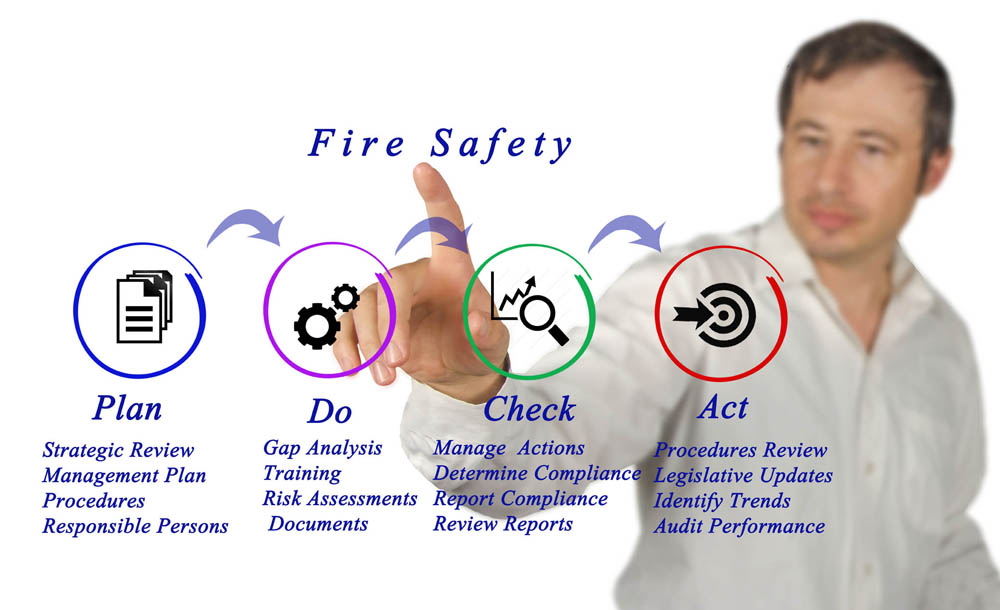If you own or run a business that employs people, there are a lot of rules and laws with which you have to comply. One of these – by no means the only one – is the Regulatory Reform (Fire Safety) Order 2005.
This rule says that as the responsible person in a business it is your duty to undertake certain steps with regard to fire safety on your premises. The “responsible person” is defined as an owner, employer, landlord, occupier, or anyone else who is in control of the premises such as a building manager, managing agent, or facilities manager for example.
It is also possible that there may be more than one responsible person. For example, in an office block, there may be several different businesses, and each has a responsible person. In this instance, the responsible persons must work together when it comes to fire safety. The Fire Safety Order also operates if you have paying guests, so you might run a bed and breakfast or guest house.
The Fire Safety Order applies to all non-domestic premises, which are defined as workplaces and commercial premises, all premises the public has access to, and the common areas of houses in multiple occupations.
As a responsible person, you must carry out a fire risk survey and, if you employ five or more people, keep a written record of your assessment. You must also tell your staff, or their representatives if you have a lot of employees, of your findings, and you must put in place appropriate fire safety measures and keep them maintained. This refers to such things as fire alarms, fire-fighting equipment, and so on. You also have to make plans for how everyone must behave if an emergency arises and you must provide staff training and fire safety instructions.
Furthermore, local fire and rescue services have the right to enter your premises and inspect them, see your written record, and issue you with any instructions for alterations or improvements that you must make. In addition, you should note that the penalties for non-compliance can be severe and can include heavy fines, and in the worst cases a prison sentence. Indeed, it has sometimes happened that responsible persons have been imprisoned for this.
When you carry out a fire risk assessment you need to do the following:
- Identify fire hazards.
- Identify people at risk.
- Evaluate, remove or reduce the risks.
- Record your findings, prepare an emergency plan and provide training.
- Review and update the fire risk assessment regularly.
Carrying out a fire risk assessment may not be too difficult if you run a small convenience store or a pub, for example. However, if you run a large business with many employees and possibly multiple locations, it becomes a whole different ball game. Do you really know what to look for? Even if you do, have you got the time to undertake such an assessment or assessments? If you are like the vast majority of businessmen, the answer is probably “no”. This is why so many businesses prefer to use our services at UK-Fire Risk Assessments because our team is trained in the art of fire risk assessments. When you use our services, you can be confident that you are fully compliant in all respects and that you have the written record that the law requires you to keep.
However, there will still be things that you are required to do. We can tell what needs to be done, but you then have to do it. For example, you need to carry out a staff fire drill. This is essential so that your staff knows how to evacuate the building quickly and safely. Two fire drills a year should be sufficient for most businesses. This also helps because in a real fire situation people may feel panicked and not know what to do. If they are used to a fire drill it induces a certain sense of composure if it happens for real.
You need to inform all employees that a fire drill is to take place, and if your business has visitors inform them also. You need to appoint a fire marshal to supervise the drill and ensure everyone gets out of the building safely, and you need to arrange for anyone with disabilities to be helped if necessary. If your fire alarm system is connected to the local fire and rescue service, you need to disconnect it, because you don’t want to waste the time of the fire service just because you are having a drill! You also need to reconnect it afterwards.
During a fire drill, you need to look for any inappropriate behaviour. For example, staff should not stop to collect coats or personal belongings. If you note any behaviour of this sort or any other issues, you must keep a record of it in your fire assessment, and obviously take steps to deal with it so that it does not occur if a real fire should break out.

